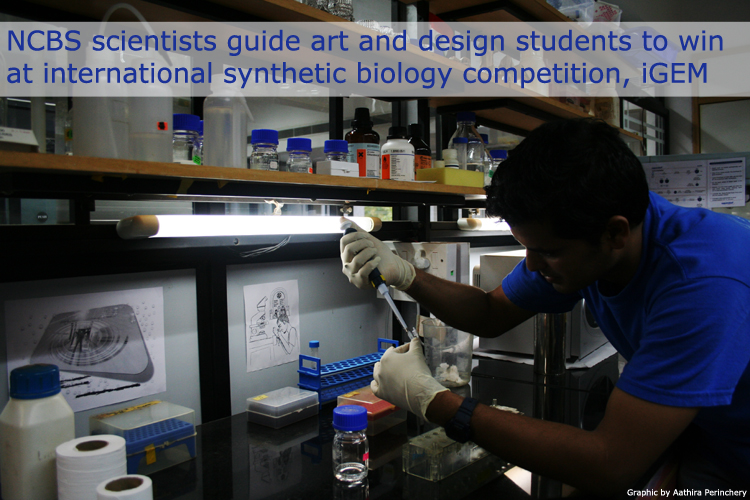NCBS scientists guide art and design students to win at international synthetic biology competition, iGEM
With basic scientific help from NCBS's Navneet Rai and Mukund Thattai, a team of students guided by Yashas Shetty from the Srishti School of Art, Design and Technology at Bangalore have done it yet again: an award at the famed International Genetically Engineered Machines (iGEM) competition at the Massachusetts Institute of Technology (MIT) at Cambridge, Massachusetts in the United States of America.
In 2009, the Srishti team won the 'Best Presentation Award' at iGEM in the Smell of Rain project in which team members cloned and created geosmin bacteria that produce the smell of fresh earth. Thattai and Rai took part in guiding that team too.
This time the 12-member strong Srishti ArtScienceBangalore team of second year art and design students has won the 'Best Human Practice' award at the World Championship Jamboree of iGEM 2011, in a tie with the Edinburgh team. "The 'Human Practice' component is to ask what are the rules by which we as the engineers should be bound, to achieve maximal output with proper social responsibility," says Thattai. For their project Searching for the Ubiquitous Genetically Engineered Machines in this category, the Srishti team asked a 'fantasy' question. A hundred years hence, the current version of synthetic biology may become popular. What if these bio-engineered organisms get out of controlled labs? If they become a part of life and our immediate environment, can we evaluate the extent to which they have spread? In order that there be data for comparison to quantify change in future, baseline data is most critical. The team realized that this baseline data was lacking: no team had ever gone out and collected existing information about the potential presence of these bio-synthetic organisms in our environment.
So the Srishti team collected almost 300 soil samples from across India: including places like Coorg, Bangalore, Chennai, Kodaikanal and Assam. With Rai's expertise, they learnt to isolated DNA from soil bacteria and produce it in bulk using the polymerase chain reaction (PCR) technique. They used specific BioBrick primers to check if there were any bio-engineered organisms in the samples. However, as expected, not a single sample contained these organisms.
That was just the field and laboratory bit. But innovation is the name of the game, and the Srishti team did just that throughout the project. For starters, they balloon-mapped all sites from where they collected each sample. By attaching a camera to a set of helium balloons on a spool of thread, they obtained aerial pictures of every site. These pictures were tagged onto each site on their sampling map, along with the molecular results of each sample from the same site. They also designed an innovative soil collection kit and their very own 'BioLab' consisting of instruments devised from commonly available materials. Their work drew towards many important questions: Can science be taken to ordinary people? Can people with a minimal background in science help with such synthetic biology projects?
"They took that idea to the people who were living in (these areas)...got the soil samples, talked to them about it. That's another piece that the judges appreciated," says Thattai. "The students were very enthusiastic and learnt well," says Rai who helped them out with the laboratory work and the principles behind DNA isolation, PCR and restriction digestion. NCBS's Aswin Seshasayee also helped the students get on top of the science by talking to them and suggesting relevant reading.
With their ingenious work, the Srishti team first won in the 'Best Human Practice' category at the Asian Regional Jamboree held at Hong Kong between 15th and 16th October 2011 and entered the World Championship stage. The international iGEM competition was conducted from the 5th to 7th November 2011 at MIT in which nearly 160 teams participated.
iGEM is a synthetic biology competition conducted annually since 2003. Undergraduate students are encouraged to think about and design living biological systems. Previously restricted to only American universities, the competition went international from 2006. Since then, Mukund Thattai has helped guide some Indian teams at iGEM. Navneet Rai has assisted Thattai with guiding Indian students for iGEM after he joined his lab at NCBS as a PhD student in 2007. Apart from the Srishti ArtScienceBangalore team, they have both worked with students from other institutes like the Indian Institute of Technology (Mumbai) and the Institute of Bioinformatics and Biotechnology (Pune), to name a few.
News stories about the award have been covered by IBNLive (12th Novmeber 2011), The Times of India (18th November 2011) and the Business Standard (4th December 2011).

Comments
Post new comment